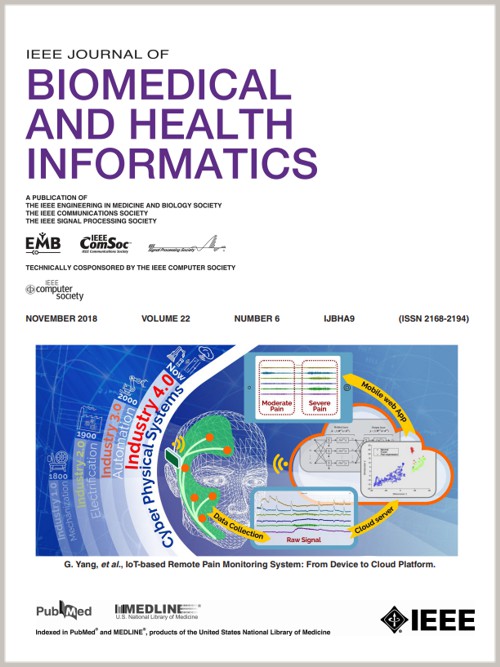SleepECG-Net:利用心电图诊断小儿睡眠呼吸暂停的可解释深度学习方法。
IF 6.7
2区 医学
Q1 COMPUTER SCIENCE, INFORMATION SYSTEMS
IEEE Journal of Biomedical and Health Informatics
Pub Date : 2024-11-11
DOI:10.1109/JBHI.2024.3495975
引用次数: 0
摘要
儿童阻塞性睡眠呼吸暂停(OSA)是一种普遍而严重的呼吸系统疾病,与心血管疾病的发病率有关。多导睡眠图是一种标准的诊断方法,但在可及性和复杂性方面面临挑战,导致诊断不足。为了简化 OSA 诊断,人们利用心脏信号开发了深度学习(DL)算法,但这些算法往往缺乏可解释性。我们的研究引入了一种新颖的可解释深度学习方法(SleepECG-Net),用于直接估计高危儿童的 OSA 严重程度。我们在隔夜心电图(ECG)信号上训练了卷积神经网络和递归神经网络(CNN-RNN)的组合。梯度加权类活化映射(Grad-CAM)是一种可解释的人工智能(XAI)算法,用于解释模型决策和提取与小儿 OSA 相关的心电图模式。因此,我们使用了来自半公开的儿童腺样体切除术试验(CHAT,n = 1610)和克利夫兰家庭研究(CFS,n = 64)以及私人的芝加哥大学(UofC,n = 981)数据库的心电图信号。在 CHAT、UofC 和 CFS 中,OSA 诊断性能的 4 级 Cohen's Kappa 分别为 0.410、0.335 和 0.249。该建议表明,随着严重程度的增加以及心血管风险的增加,诊断性能也会提高。XAI 的研究结果突出了与 OSA 相关的既定心电图特征的检测,如心动过缓-心动过速事件和呼吸暂停/呼吸暂停发生时的延迟心电图模式,重点是事件群。此外,Grad-CAM 热图还能识别显示心血管风险的潜在心电图模式,如 P 波、T 波和 U 波、QT 间期和 QRS 波群变化。因此,SleepECG-Net 方法可以通过提供心脏风险因素信息来改善儿科 OSA 诊断,从而增强临床医生对自动系统的信心,并促进其在临床实践中的有效应用。本文章由计算机程序翻译,如有差异,请以英文原文为准。
SleepECG-Net: Explainable Deep Learning Approach With ECG for Pediatric Sleep Apnea Diagnosis
Obstructive sleep apnea (OSA) in children is a prevalent and serious respiratory condition linked to cardiovascular morbidity. Polysomnography, the standard diagnostic approach, faces challenges in accessibility and complexity, leading to underdiagnosis. To simplify OSA diagnosis, deep learning (DL) algorithms have been developed using cardiac signals, but they often lack interpretability. Our study introduces a novel interpretable DL approach (SleepECG-Net) for directly estimating OSA severity in at-risk children. A combination of convolutional and recurrent neural networks (CNN-RNN) was trained on overnight electrocardiogram (ECG) signals. Gradient-weighted Class Activation Mapping (Grad-CAM), an eXplainable Artificial Intelligence (XAI) algorithm, was applied to explain model decisions and extract ECG patterns relevant to pediatric OSA. Accordingly, ECG signals from the semi-public Childhood Adenotonsillectomy Trial (CHAT, n = 1610) and Cleveland Family Study (CFS,n = 64), and the private University of Chicago (UofC, n = 981) databases were used. OSA diagnostic performance reached 4-class Cohen's Kappa of 0.410, 0.335, and 0.249 in CHAT, UofC, and CFS, respectively. The proposal demonstrated improved performance with increased severity along with heightened cardiovascular risk. XAI findings highlighted the detection of established ECG features linked to OSA, such as bradycardia-tachycardia events and delayed ECG patterns during apnea/hypopnea occurrences, focusing on clusters of events. Furthermore, Grad-CAM heatmaps identified potential ECG patterns indicating cardiovascular risk, such as P, T, and U waves, QT intervals, and QRS complex variations. Hence, SleepECG-Net approach may improve pediatric OSA diagnosis by also offering cardiac risk factor information, thereby increasing clinician confidence in automated systems, and promoting their effective adoption in clinical practice.
求助全文
通过发布文献求助,成功后即可免费获取论文全文。
去求助
来源期刊

IEEE Journal of Biomedical and Health Informatics
COMPUTER SCIENCE, INFORMATION SYSTEMS-COMPUTER SCIENCE, INTERDISCIPLINARY APPLICATIONS
CiteScore
13.60
自引率
6.50%
发文量
1151
期刊介绍:
IEEE Journal of Biomedical and Health Informatics publishes original papers presenting recent advances where information and communication technologies intersect with health, healthcare, life sciences, and biomedicine. Topics include acquisition, transmission, storage, retrieval, management, and analysis of biomedical and health information. The journal covers applications of information technologies in healthcare, patient monitoring, preventive care, early disease diagnosis, therapy discovery, and personalized treatment protocols. It explores electronic medical and health records, clinical information systems, decision support systems, medical and biological imaging informatics, wearable systems, body area/sensor networks, and more. Integration-related topics like interoperability, evidence-based medicine, and secure patient data are also addressed.
 求助内容:
求助内容: 应助结果提醒方式:
应助结果提醒方式:


